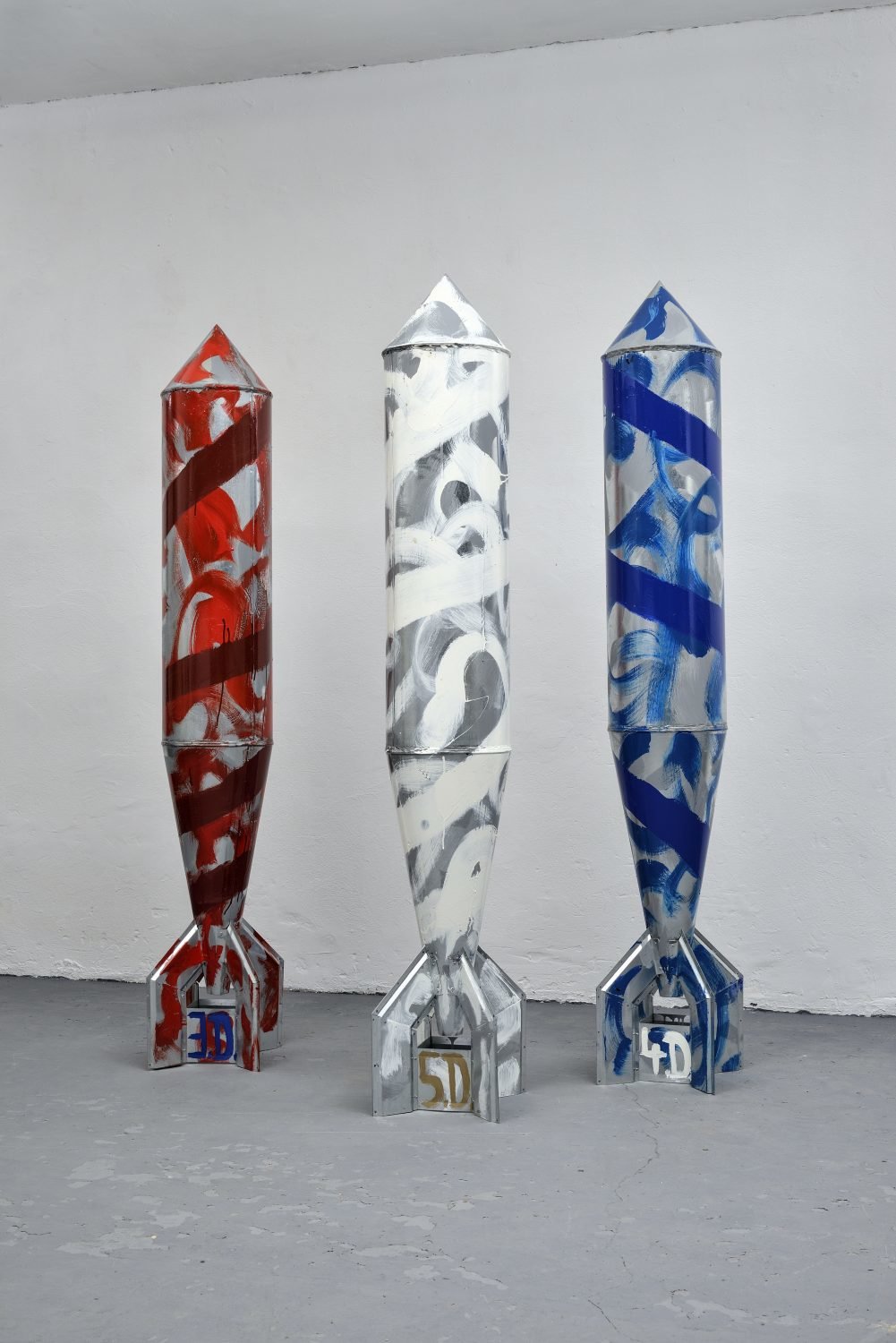Rockets and Space
Main Hall

DSUQ 4.D. Rocket / DSUQ 4.D. Raketa, 2000
Welded metal sheet, acrylic
3 objects, each 200 × 30 × 30 cm
Rockets are a recurring motif that Filko used in different media and phases of his work. Visitors to the exhibition encounter them as sculptural objects in the main hall, where there are a number of rockets in different sizes and colors. On the left, Rockets 5.4.3.D. (2000) is presented, with its three objects in the three basic dimensions of Filko’s ordering system he called System SF. The silver rocket shape is made more dynamic — and also gains a certain banality and irony — through quickly undertaken gestural painting in each of the three colors red (3rd dimension), blue (4th dimension), and white (5th dimension).
Opposite them on the right is the installation Chakra Colors Rockets – Bombs (1985), a row of seven bomb-like rocket objects. The dimensions have now expanded and the later System SF here manifests itself in a series of seven colors or chakras. The shapes here lead to associations of space travel and military weapon, so that on the one hand we note the historical context with military armament and attempts to take possession of space. On the other hand, Filko here expresses his inexorable will to artistic expression, a determination that transcends all borders between nations and political systems and that does not shy away from occasionally violent gestures.
The rocket motif is particularly powerful in the six-meter high sculpture DSUQ 4.D. Rocket (2000). This work is an enactment of the 9th chakra in Filko’s system, as denoted by the silver color and the lettering “IR 9.” While Filko’s early rockets addressed (geo-)political and ideological contexts, the reference here to his System SF stresses the significance of this work within his artistic worldview. The silver chakra belongs to the highest dimensions and stands for transcendence.
An installation in three parts hangs from the ceiling. Here Filko also takes a sculptural approach to the rocket motif in terms of the relationship between its outlines and physical body, but he also resolves this tension through painting. The elements of the work TIMESPACE‑4.3.D. (Rockets) of 1968/1993 are each different on each side, with the rockets seen on the one side as broad and flat spaceships in blue and black. On the other side there are various color fields that are given spatial depth by means of flanking wooden bars, so that they are also reminiscent of an easel. This installation derives its energy from the tension between spatial object and painterly sign.
Visitors encounter the rocket shape again in the side gallery, with the installation The Universal Environment (1966−67). Here the motifs are on transparent banners that have great presence in the physical space of the gallery but are nonetheless flat surfaces. Here too, these rockets reflect the geopolitical relations between Russia and America and address global themes such as armament and the conquering of outer space. In the series Maps of the World (Rockets) (1967) the colored outlines of rockets are drawn on world maps and cover up various countries and continents. This motif is also seen as an outline drawn onto photographs from the series Sculptures of the Twentieth Century (1968−69), on show in the lower level of the museum.
There is also a sexual connotation in these motifs. With his rockets, Filko also developed a clearly phallic theme that sees the conquering of cosmic space and aggressive demonstration of power of as male projects. This project expresses an ideological component in line with the chauvinism of the 1960s, in which male power relations are extended ad infinitum and at the same time adopt a universal gaze looking down at the world “from above,” while the connection with the theme of technical progress asserts a strong authority to explain and define the world. It is not entirely clear whether Filko took a critical view of these problematic aspects, or whether he rather affirmed them in terms of a specific historical moment of transcending prevailing conditions and abandoning a reality he certainly experienced as oppressive. Thus questions are raised here as to the position and place, and the “flexibility” of Filko’s artistic system and its utopian potential.
Rockets 5.4.3.D. / Rakety 5.4.3.D., 2000
Welded metal sheet, acrylic
3 objects, each 200 x 30 x 30 cm
Chakra Colors Rockets – Bombs / Rakety – bomby vo farbách čakier, ca. 1985
Found objects, metal, oil paint
7 objects, each 107 x 35 x 35 cm
DSUQ 4.D. Rocket / DSUQ 4.D. Raketa, 2000
Metal sheet, acrylic, perforation
600 x 67 x 67 cm
First Chakra Rocket / Raketa prvej čakry, ca. 2005
Metal sheet, paint
300 x 100 x 100 cm
10th Chakra Rocket / Raketa 10-tej čakry, ca. 2005
Metal sheet, acrylic
400 x 83 x 83 cm
TIMESPACE‑4.3 D. (Rockets) / TIMESPACE‑4.3.D. (Rakety), 1968/1993
Wood, acrylic and other materials
3 objects, 180 x 108 x 12 cm, 208 x 108 x 11cm, 197 x 104 x 8 cm
All works Courtesy Linea Collection, Bratislava; Layr, Vienna